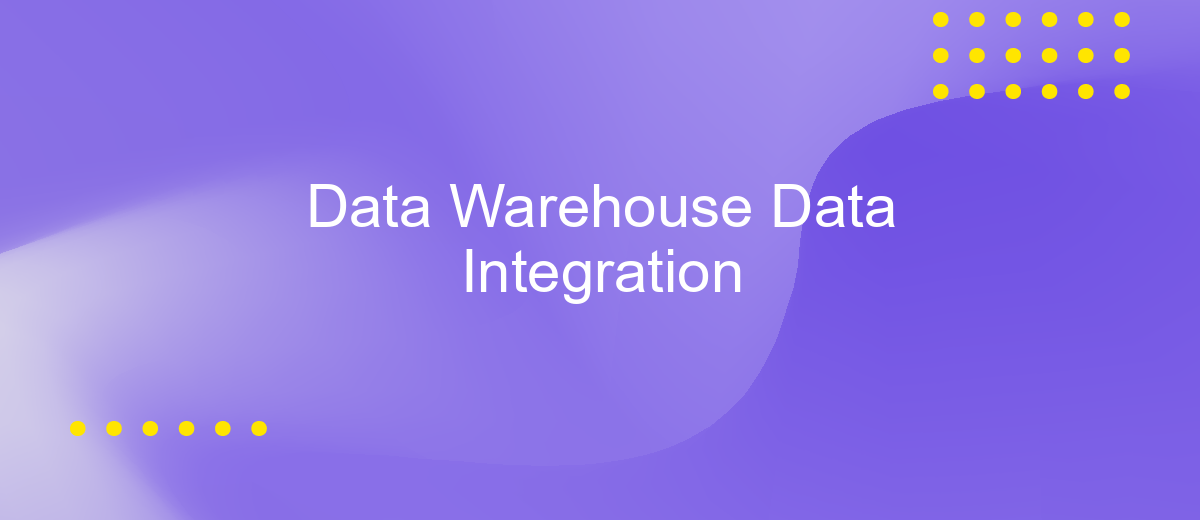Data Warehouse Data Integration
In today's data-driven world, effective data integration within a data warehouse is crucial for businesses to harness the full potential of their information assets. By seamlessly combining data from various sources, organizations can achieve a unified view, enabling more accurate analytics, informed decision-making, and streamlined operations. This article explores the key methods and best practices for successful data warehouse data integration.
Introduction
Data integration within a Data Warehouse (DW) is a critical aspect of modern data management. It involves combining data from different sources into a single, unified view, enabling better decision-making and analytics. This process ensures that data is accurate, consistent, and accessible, which is essential for businesses looking to leverage their data assets effectively.
- Data Extraction: Gathering data from various sources such as databases, cloud services, and flat files.
- Data Transformation: Converting data into a consistent format, ensuring compatibility and quality.
- Data Loading: Inserting the transformed data into the Data Warehouse for analysis and reporting.
Effective data integration in a DW environment helps organizations gain insights from disparate data sources, improve operational efficiency, and support strategic decision-making. As data volumes and complexity continue to grow, robust data integration strategies become increasingly vital for maintaining a competitive edge in the marketplace.
Data Warehousing Concepts

Data warehousing is a method of collecting, storing, and managing large volumes of data from various sources to provide meaningful business insights. The core concept revolves around creating a centralized repository where data from different databases, applications, and external sources can be integrated and analyzed. This centralized data repository, known as a data warehouse, enables organizations to perform complex queries and generate reports that aid in decision-making processes. Key components of a data warehouse include the ETL (Extract, Transform, Load) process, data storage, and data access tools.
Effective data integration is crucial for the success of a data warehouse. Tools and services like ApiX-Drive facilitate seamless data integration by automating the transfer of data between various systems and applications. ApiX-Drive supports a wide range of integrations, ensuring that data from different sources can be easily consolidated into the data warehouse. This not only saves time but also reduces the risk of errors associated with manual data handling. By leveraging such integration services, organizations can ensure that their data warehouse remains up-to-date and accurate, providing reliable insights for strategic planning and operations.
Data Integration Overview

Data integration is a critical component in the architecture of a data warehouse, enabling the seamless consolidation of data from various sources into a unified repository. This process ensures that disparate data, whether structured or unstructured, is harmonized and made available for analysis and reporting. Effective data integration not only improves data quality and consistency but also enhances decision-making capabilities across the organization.
- Data Extraction: Gathering data from multiple sources such as databases, cloud services, and legacy systems.
- Data Transformation: Converting extracted data into a consistent format, including cleaning, validating, and enriching the data.
- Data Loading: Inserting the transformed data into the data warehouse, ensuring it is organized and accessible for end-users.
Implementing a robust data integration strategy is essential for organizations aiming to leverage their data assets effectively. By automating and optimizing the integration process, businesses can reduce manual effort, minimize errors, and accelerate the delivery of actionable insights. As data volumes continue to grow, scalable and flexible data integration solutions become indispensable for maintaining a competitive edge.
Techniques for Data Integration

Effective data integration is crucial for the success of a data warehouse. It involves combining data from different sources into a unified and consistent view. This process ensures that data is accurate, complete, and readily available for analysis and reporting. Achieving seamless data integration requires a variety of techniques and tools.
One common technique is ETL (Extract, Transform, Load), which extracts data from source systems, transforms it into a suitable format, and loads it into the data warehouse. Another approach is ELT (Extract, Load, Transform), where data is first loaded into the warehouse and then transformed. Additionally, data virtualization allows access to data in real-time without physical movement.
- ETL (Extract, Transform, Load)
- ELT (Extract, Load, Transform)
- Data Virtualization
- Data Replication
- Change Data Capture
Each technique has its own advantages and is suitable for different scenarios. For instance, ETL is ideal for batch processing, while data virtualization is beneficial for real-time data access. By selecting the appropriate integration method, organizations can ensure efficient and accurate data consolidation, leading to better decision-making and insights.


Case Studies and Best Practices
One notable case study in data warehouse data integration involves a retail company that successfully streamlined its operations using ApiX-Drive. By integrating various data sources such as sales, inventory, and customer feedback into a centralized data warehouse, the company was able to achieve real-time data synchronization. This not only improved decision-making processes but also enhanced customer satisfaction through more personalized marketing strategies. The seamless integration facilitated by ApiX-Drive allowed the retail company to automate data flows, reducing manual errors and operational costs significantly.
Another best practice in data warehouse data integration is demonstrated by a healthcare organization that leveraged ApiX-Drive to unify patient records, billing information, and treatment histories. By consolidating disparate data sources into a single, accessible platform, the organization improved data accuracy and accessibility for healthcare providers. This integration enabled more efficient patient care, timely billing, and comprehensive reporting. Utilizing ApiX-Drive's robust integration capabilities, the healthcare organization minimized data silos and ensured compliance with data protection regulations, ultimately leading to enhanced operational efficiency and patient outcomes.
FAQ
What is Data Warehouse Data Integration?
Why is Data Warehouse Data Integration important?
What are the common challenges in Data Warehouse Data Integration?
How can I automate Data Warehouse Data Integration processes?
What are the best practices for Data Warehouse Data Integration?
Routine tasks take a lot of time from employees? Do they burn out, do not have enough working day for the main duties and important things? Do you understand that the only way out of this situation in modern realities is automation? Try Apix-Drive for free and make sure that the online connector in 5 minutes of setting up integration will remove a significant part of the routine from your life and free up time for you and your employees.

